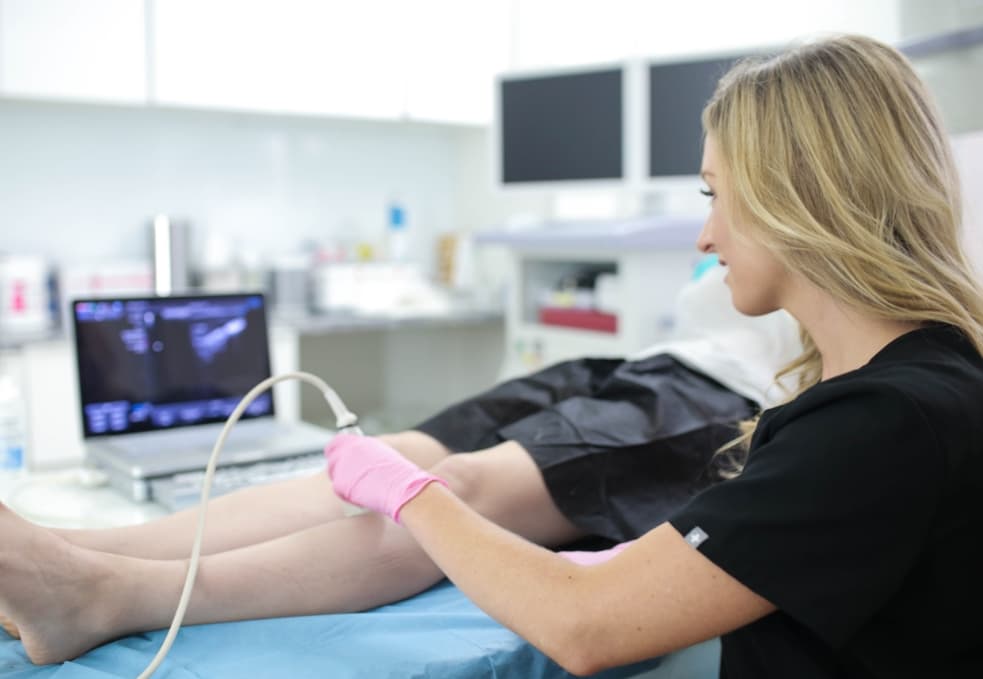What are the common vein damage symptoms?
If you’re concerned about vein damage, you may have spider veins, varicose veins, leg heaviness, or other such symptoms. Chronic venous insufficiency is the primary root cause of vein damage symptoms. When you have chronic venous insufficiency, blood continues accumulating in your leg veins, eventually leading to poor blood circulation, vascular dilation, and numerous vein damage symptoms. Most vascular conditions are chronic, so you need to identify and treat them at the earliest stage possible to prevent them from worsening.
The symptoms of vein disease appear gradually. The initial signs and symptoms of vein damage are fairly mild and can even be mistaken for signs of aging. The earliest symptoms of vein disease include leg heaviness, restless leg syndrome, frequent leg cramps, leg pain, leg swelling, and spider veins. Most signs and symptoms of vein disease worsen at the end of the day or after long periods of sitting or standing still. If you don’t seek treatment promptly, the vein damage symptoms will continue worsening.
Eventually, you may develop varicose veins, skin discoloration, leg ulcers, and also the symptoms of deep vein thrombosis (blood clots in leg veins). That’s why you must contact reliable vein doctors in your location when you notice vein damage symptoms. The board-certified vein doctors at our state-of-the-art vein centers in Long Island perform thorough diagnostic tests to curate a personalized vein treatment plan for you. Our considered approach to vein care ensures safe and consistent results without harsh side effects or downtime.
We have state-of-the-art vein centers in West Island, Jericho, and Hampton Bays. Please schedule an appointment at your nearest vein center in Long Island.

Why are veins popping out on my legs?
If veins are popping out on your legs, you probably have underlying vein disease. Varicose veins are dense masses of puffy blood vessels that bulge out of your skin’s surface, usually looking like a mass of twisted, tangled, and knotted ropes. The presence of puffy varicose veins on your legs means you have excess blood accumulation in your leg veins, which is usually indicative of chronic venous insufficiency. You should consult a vein doctor for a diagnosis and treatment as soon as possible.
What is chronic venous insufficiency?
Chronic venous insufficiency is the root cause of most vein problems, including varicose veins and spider veins. Venous insufficiency is a circulatory disorder caused by the collapse of vein valves. In healthy veins, the valves act as one-way doors that ensure smooth blood circulation to the heart, usually against the force of gravity. When your vein valves collapse or malfunction, blood flows backward and accumulates in the leg veins, leading to vascular dilation and the formation of varicose veins.
Can I get varicose veins in the wrist?
Varicose veins usually occur in the lower extremities of the body, such as the legs and thighs. That’s because varicose veins occur when blood flows backward because of gravity (and collapsed vein valves), leading to blood accumulation in leg veins. The veins in your legs must carry blood to the heart against the force of gravity, so the collapse of vein valves can be problematic.
But the veins in the wrist and other parts of the body don’t come under the pressure of gravity, so they’re less likely to develop varicose veins. But even so, varicose veins can develop anywhere on the body, including the wrists and hands. The risk of varicose veins in the wrist might be lower than varicose veins in the legs, but it’s not nonexistent.
What are the varicose vein stages?
- Spider Veins: You may develop small clusters of dense blood vessels and broken capillaries, which are visible underneath the skin’s surface. Unlike varicose veins, they don’t bulge out of the skin’s surface.
- Varicose Veins: You develop large, protruding, rope-like blood vessels that bulge out of the skin’s surface. Varicose veins usually look like a mass of tangled, twisted, and knotted ropes bulging out of the legs.
- Leg Swelling: Your legs, ankles, and wrist may appear swollen and enlarged because of the accumulation of blood in your leg veins. Elevating the legs may alleviate the symptoms temporarily, but the swelling will return.
- Skin Discoloration: Over time, your skin color and texture will start changing into a rusty shade, and parts of your skin will look pale because of the lack of effective blood circulation in your legs. Your skin may also look leathery.
- Leg Ulceration: If you have any scratches or injuries in your legs, they won’t heal properly because of the lack of blood circulation, eventually leading to non-healing wounds.
Do men get varicose veins?
Varicose veins are more common in women, but men can also get varicose veins. Vein disease is more common amongst women because the female hormones (estrogen and progesterone) can weaken the vein valves, thus increasing the risk of collapsed vein valves and venous insufficiency. However, gender isn’t the only risk factor for varicose veins — other risk factors include genetics, age, weight, pregnancy, and occupation.
When should I consult a vein doctor?
You should consult a vein doctor when you notice the first signs and symptoms of chronic venous insufficiency. The earliest symptoms of vein disease include leg heaviness, restless leg syndrome, frequent leg cramps, leg pain, weakness, and spider veins. If you notice these vein problems, please consult board-certified vein doctors.
Schedule an appointment at the best vein centers in Long Island
Long Island Vein Centers is a group of state-of-the-art vein centers in Long Island. We have offices in West Islip, Jericho, and Hampton Bays, making vein care accessible to patients throughout Long Island. Please schedule an appointment to explore your minimally invasive spider vein and varicose vein treatments at our vein centers in Long Island.

